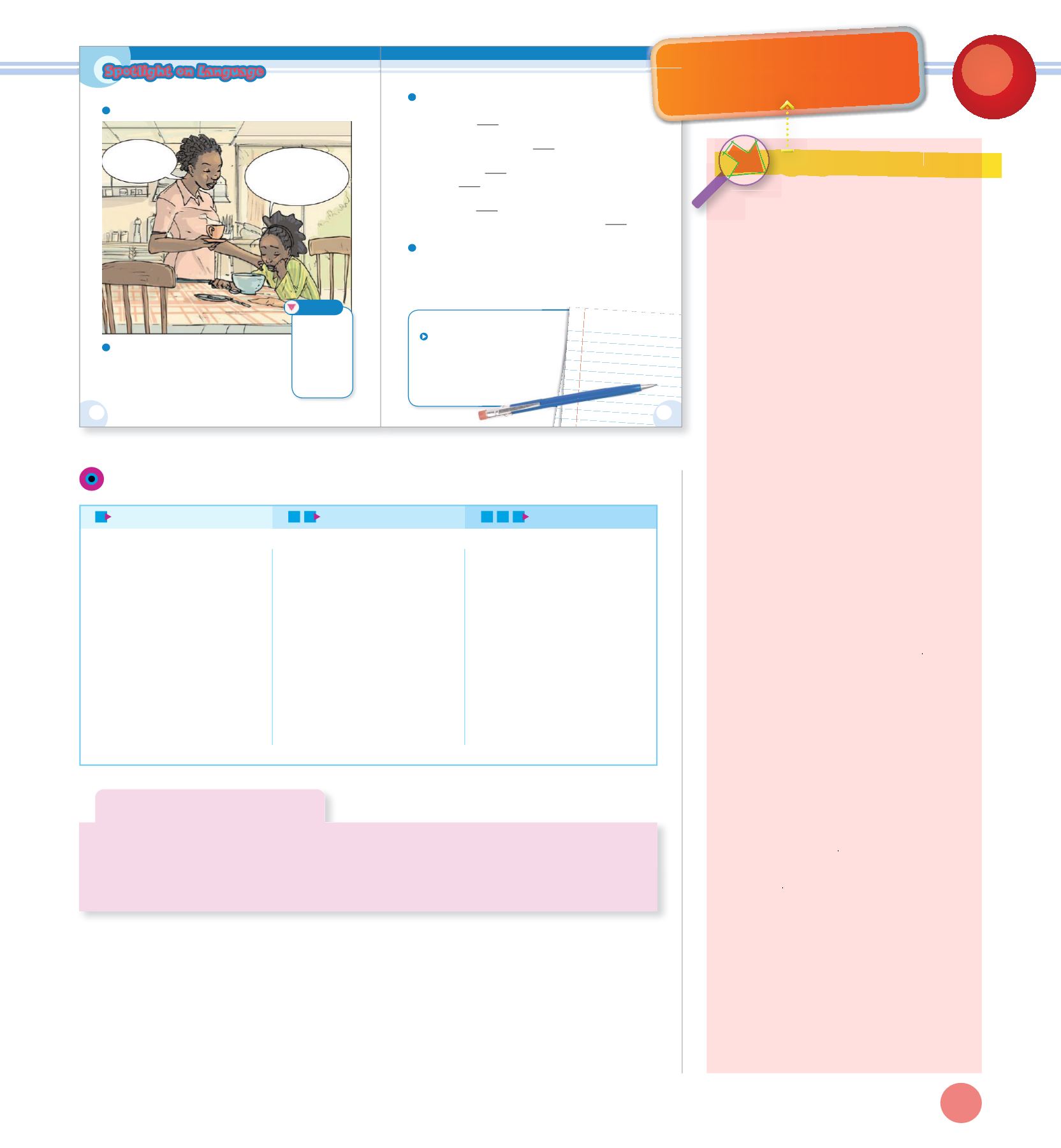

My Community
Unit 4
125
$
Spotlight on Language
*> #47)8
You’re right. I’munhappy.
Davidand Ihadaplan togo to
theColonialTheater thisafternoon.
Now,hedoesn’twant togo.
What’swrong?
Youdon’t lookhappy.
$
.89*3 94 9-* (43;*78&9.43
38<*7 9-* 6:*89.438 .3 (4251*9* 8*39*3(*8
#-&9 2&0*8 >4: -&55> &3) <-&9 2&0*8
>4: :3-&55>
4< )4 >4: 89&79 & (425:9*7 4< .8 9-&9
).++*7*39 +742 -4< 94 7*89&79 & (425:9*7
).8&,7**
.25488.'1*
7*89&79
7*9-.30
:3&'1*
:3-&55>
:3:8:&1
$
%#
-448* 9-* (477*(9 <47) 94 (4251*9* 9-* 8*39*3(*8
&;.) )4*83
’
9 <&39 94 ,4 94 9-* 4143.&1 -*&9*7
* &3) 43.&
&,7** ).8&,7**
43.&
’
8 249-*7 )4*83
’
9 9-.30 9-&9 9-* 4143.&1 -*&9*7 .8 1.0* 49-*7
9-*&9*78 47 -*7 9-* 9-*&9*7 .8
:8:&1 :3:8:&1
43.& )4*83
’
9 9-.30 9-&9 8-* (&3 )4 *;*7>9-.3, -* A3)8 4:9 9-&9
842* 9-.3,8 &7*
+47 -*7 5488.'1* .25488.'1*
43.& .8
'*(&:8* -*7 (4:8.3 &;.) )4*8 349 <&39 94 ,4 94
9-* 9-*&9*7 &8 51&33*) -&55> :3-&55>
43.& 97.*8 94
9-* (425:9*7 ':9 8-* (&3349 89&79 7*89&79
43.&
’
8 249-*7 9-.308 .9
’
8 '*89 +47 43.& &3) &;.) 94
9-*.7
<**0*3) 51&38 9-.30 7*9-.30
38<*7 9-* 6:*89.438 .3 (4251*9* 8*39*3(*8
4< )4*8 9-* 2*&3.3, 4+ & <47) (-&3,* <-*3 >4: &99&(-
re-
94 9-* '*,.33.3, 4+ .9
4< )4*8 9-* 2*&3.3, 4+ & <47) (-&3,* <-*3 >4: &99&(-
un-
94 9-* '*,.33.3, 4+ .9
I &disagree &with &my
&mom &when &she &wants
&me &to &go &to &bed &early.
I &want &her &to &rethink
&my &bedtime.
!! (
#7.9* &'4:9 ).8&,7**.3,
*8(7.'* & 8.9:&9.43 9-&9 2&0*8
>4: ).8&,7** <.9- 842*43*
#-*3 >4: ).8&,7** <.9- 842*43*
)*8(7.'* -4< >4: 97> 94 2&0* 9-&9
5*7843 &,7** <.9- >4:
Targeting Proficiency Levels
Work as a class to answer
the vocabulary questions.
Copy sentences on the
board from the track
script to provide context
clues for the class.
Work as a class to answer
the vocabulary questions.
Elicit definitions from
the words in question
and the context in which
they were used. Next,
ask students to discuss
what the words have in
common, and to list other
words that would fit the
same pattern.
Work as a class to answer
the vocabulary questions.
Discuss with students the
meanings of the words in
question. Ask them to try
to recall sentences from
the conversation in which
the vocabulary words
were used.
Beginning
Intermediate
Advanced
Meeting Individual Needs
You may assist students who exhibit difficulty with auditory comprehension by providing
a written copy of the track script and allowing them to read along as they listen to the
CD.
t
s
prefix
is small group of letters that
can be added to the beginning of
a word to form a new word with
a different meaning. Knowing the
meanings of certain prefixes can help
students to decode many unfamiliar
words.
Q
Some prefixes express numbers.
The
tri
in
tricycle
means “three”
(wheels), whereas the
bi
in
bicycle
means “two” (wheels).
Q
Some prefixes express time, order,
or sequence. When discussing
tests, a
pre
test is given before the
lesson is taught, and a
post
test is
given after the lesson is taught.
Q
Some prefixes express size. The
micro
in
microscopic
or
microfiber
means very “very small.”
Q
Some prefixes express
opposites. Words like
impossible
,
indescribable
,
irreplaceable
,
and
unbelievable
have opposite
meanings when the
im
,
in
,
ir
, and
un
prefixes are deleted.
Q
Some prefixes express location.
The prefix
under
in the word
underwear
tells where you wear it.
Q
Some prefixes express
togetherness. The prefix
co
in the
word
cooperate
means “operate
together.”
Q
Some prefixes express amount.
The prefix
over
, as in
overactive
,
means “too much.” The prefix
under
, as in
underweight
, means
“too little.” The prefix
multi
, as in
multiuse
, means “many.”
Model the correct use of prefixes
by using words with prefixes in
sentences, emphasizing the prefix.
Q
Choose a student who is wearing
a shoe with laces. Ask that student
to untie his or her laces. Then, ask
the student to retie the laces.
A
efixe Pr
ect Instruc ion
Direct Instruction
provides the
flexibility to teach grammar explicitly.
Dir
43


















